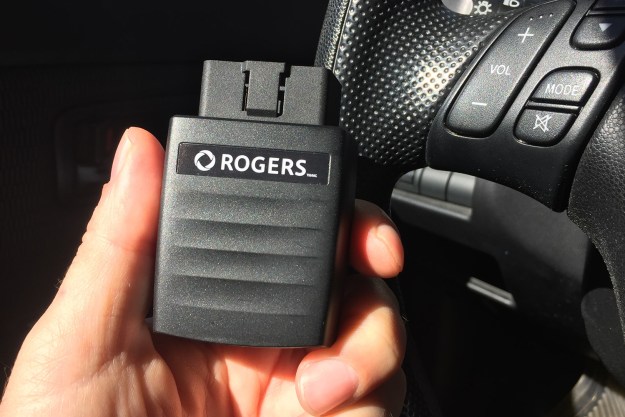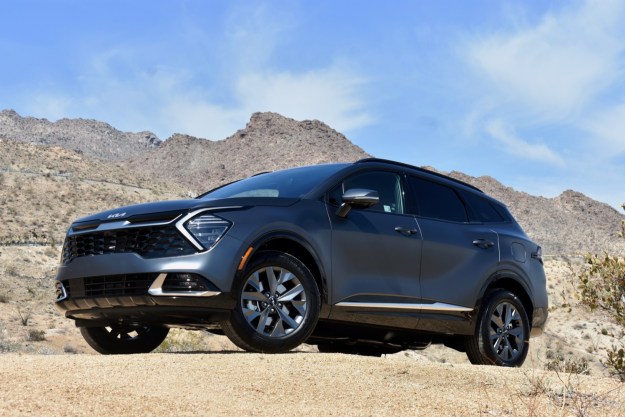
“The easy to set-up Smart Drive turns your car into a fully independent connected device.”
- Super easy set-up
- No need for a phone in the car
- Easy, automatic trip logs
- Good tool for parents
- Smartphones already have most features
- Expensive for what you get
- 1 GB of data only free for a year
In addition to putting supercomputers in our pockets, our smartphones have transformed our cars into rolling communication hubs, able to take calls, broadcast streaming or stored music, give us driving directions, and even read our texts and emails to us. They’re so useful, it’s hard to imagine a device that could make our cars smarter, but ZTE thinks it has done just that, and is rolling out a new product in conjunction with cellular carriers, which combines in-car LTE Wi-Fi with real-time vehicle info.
In Canada, it’s called Rogers Smart Drive or Telus Drive+, while in the US it’s called T-Mobile SyncUp Drive. In the coming months, you’ll start to see it offered by many more carriers, each under its own brand. Here’s our review of the Rogers Smart Drive: We took it for a test drive to see what it’s all about and whether or not you should consider adding it to your vehicle.
Plug it in and drive away
Most people will simply plug it in and never touch it again.
Rogers Smart Drive ($99 on a two-year contract, plus $15 per month) is a small dongle that plugs into your car’s OBDII port, and communicates with an LTE cellular network via a micro SIM card. It has on-board GPS, as well as an accelerometer. Setting it up is incredibly easy, thanks to the free Rogers Smart Drive app (iOS/Android), which walks you through the process in less than two minutes — it even helps you find your OBDII port in case you haven’t a clue where it is.
Once activated, Smart Drive enables two main functions: an LTE Wi-Fi hotspot for up to five connected devices, and a dashboard within the app that displays info about your vehicle like fuel level, battery health, location, and diagnostic warnings. Though you can move the Smart Drive from one car to another, most people will simply plug it in and never touch it again.
Your car is now part of the IoT
Unlike your smartphone, the Smart Drive turns your car into a fully independent connected device. As long as it’s within range of a cellular network, it can communicate with you (or anyone else you add to your account), which has some real advantages. The biggest is being able to keep tabs on your car whether you’re 10 feet or 10,000 miles away from it. You can configure alerts that let you know when your car was started, stopped, or — thanks to the accelerometer — if someone has intentionally or unintentionally messed with it. Some of these work better than others: in our testing, car starts and stops always generated alerts, as did a door open or close when the key wasn’t in the ignition, however even a very aggressive side-to-side rocking of the car didn’t trigger a disturbance alert.
If you’re the only driver of your car, you may not care so much about trip starts and stops, but if you’re a parent of a teen driver, or perhaps you provide a vehicle for a caregiver to use, these alerts could help you know how your car is being used. The app also lets you create multiple geofences, with radii of 0.1 to 25 miles of specified locations, another handy feature in case you’ve told your kid that the car is strictly for getting to school and back, with no side trips. It’s also a good way of finding out if a valet pulled a Ferris Bueler on you.
Inside info
With read-only access to the OBDII port (don’t worry, no one can use Smart Drive to hack your car’s electronics) the dongle can keep you informed of any changes to your car’s status. It uses the Vancouver-based Mojio connected car platform to interpret the myriad factory diagnostic trouble codes (DTC) into something you can understand and therefore take action on. Instead of seeing that ominous “check engine” light, and then rushing back to your mechanic, Smart Drive can display the more informative “Random/Multiple Cylinder Misfire Detected” and tell you if it’s something you need to look after immediately, or if it can wait, with a severity rating. The app won’t tell you a whole lot about what the issue is, but it does tell you the error code — in this case “P0300” — so you’ll be able to look it up on a resources like OBDCodes.com. At the very least, you’ll be better informed when your mechanic discusses possible fixes. As luck would have it, one week into our test, our 2008 Mazda 3 graced us with a check engine light. Normally, you’d have to proceed immediately to your mechanic to determine the severity of the problem, but a quick glance at the Smart Drive app’s vehicle info section revealed “Code P0507, Idle Air Control System RPM Higher Than Expected.” Definitely a reason to get the car checked out, but hardly “park your car immediately and call a tow truck” territory — which is exactly what drivers need to know.
The same OBDII data gives you readings on your fuel level and battery health, which when combined with GPS data, can produce some interesting reports. Each trip you take is logged, with start and end times and locations. From this data, the Mojio platform can infer the total distance, duration and approximate fuel economy. You can tag any of your trips as “Business” (oddly, there’s no way to add additional categories) and you can export either the full history or just selected timeframes as a CSV or PDF file, which is sent to the email address you used to sign up. Anyone who uses their car for work and needs to submit trip reports will love this feature.
These are good insights for sure, but when it comes to keeping an eye on new drivers, they’re invaluable.
The trip logs also include stats on the average speed, maximum speed, maximum engine RPM, how many times the car rapidly accelerated or harshly braked, and how long the car stood idling. For primary drivers, these are good insights for sure, but when it comes to keeping an eye on new drivers, they’re invaluable. Simply knowing that their driving habits are being recorded and inspected may be enough to keep teens from becoming their own worst enemy while on the road.
The downside of this arrangement is that you can only have one device plugged into your OBDII port. If you’re enrolled in an insurance saving program that uses a dedicated OBD device, you’ll have to choose which one matters most to you.
Wheels with Wi-Fi
Do you really need a Wi-Fi hotspot in your car if you have a smartphone that has its own hotspot feature? We don’t really think so, but mobile carriers think it’s a must-have. Having an always-on Wi-Fi hotspot in your car is a guaranteed way for them to increase their ARPU (average revenue per user). In the case of Smart Drive, Rogers charges $15 a month for the service, and this currently includes 1GB of mobile data as a “bonus,” for the first 12 months. After the first year, you’ll presumably be paying on top of the $15 for all of your consumed data. The good news is that Wi-Fi over LTE is superbly fast, and you’ll have no problem streaming multiple HD movies at once, provided your wallet is up to the task of paying.
There’s no reason to think that the Smart Drive’s LTE connection will be any stronger than that of your existing smartphone — one of the selling points of factory in-car Wi-Fi, like the kind offered by GM — but there’s a slight benefit to having data connectivity that isn’t tied to your smartphone’s battery. This may come in handy when you forget to bring along a charging cable.
Why do I need this thing?
With the exception of the vehicle info that Smart Drive has access to via the OBDII port, there’s not much functionality that can’t be easily replicated with a smartphone and a few good apps. Geofencing, trip logging, Wi-Fi hotspotting, and parking reminders are all easily added to iOS or Android these days.
Paying $99 up-front, and then a minimum of $15 a month for two years to enjoy the OBD-powered features seems expensive, especially when you consider the amount of mobile data consumed by Smart Drive (when you don’t count Wi-Fi usage) is estimated at a mere 25Mb per month. We’re not convinced that most drivers will get $459 worth of value out of this device over the course of the two year term, with concerned parents of teen drivers being the exception.
Contrast this with the Zubie — an essentially identical device without LTE or Wi-Fi hotspot features — which is free to buy and only costs $100 per year to use. We think that’s still pricey, but given that these devices also increase your chances of recovering a stolen vehicle, perhaps it’s worth it.
Warranty information
The Rogers Smart Drive comes with a 1-year manufacturer’s warranty from ZTE.
Our Take
We really like the smart car features enabled by the Rogers Smart Drive, but the price is hard to stomach. Given how many of its features are already available via smartphones, we think it should cost a lot less to buy and operate.
Is there a better alternative?
Rogers Smart Drive, Telus Drive+, and T-mobile SyncUp Drive are all Mojio-powered, LTE connected OBDII dongles, but there are others as well. We’ve found competing products from Automatic, Carlock, and Dash, just to name a few. Each offers a slightly different feature set, with different price points and coverage areas. The goal for buyers should be to figure out which of these products gives you the features you need without making you pay a premium for those you don’t.
How long will it last?
With no moving parts and a high likelihood that it will stay plugged in for the duration, the Rogers Smart Drive dongle should continue to operate for years. But keep in mind, without a mobile subscription, the device is worthless except as a resale item.
Should you buy it?
If you’re a parent of a teen driver, Rogers Smart Drive gives you all the tools you need to check up on how (and where) your kids are driving. Add to this its helpful diagnostic info, theft notification, recovery options, and Wi-Fi hotspot functions, and you’ve got a significant tech upgrade for your vehicle. If you value all of these features and think they justify the upfront cost as well as the monthly fee, you should buy it. The device is easy to install and use, and works well.
On the other hand, if you’re the only driver of your vehicle, many of Smart Drive’s features are either unnecessary, or readily available as free or paid apps on your smartphone. We think you’d be better off with another product that delivers just the features you need at a lower price point.
Editors' Recommendations
- The 5 best smart motorcycle helmets in 2024
- 2024 Mercedes-AMG S63 E Performance first drive review: high-performance plug-in
- Hyundai Ioniq 6 first drive review: welcome to the future
- 2022 Volkswagen ID. Buzz first drive review: The iconic hippie hauler goes electric
- 2022 Mercedes-Benz EQB first drive review: An EV better than its gas sibling










